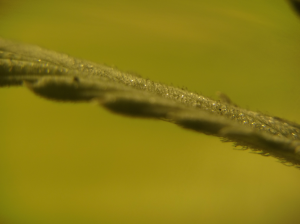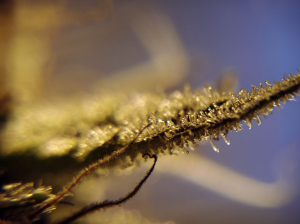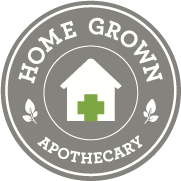What is THC, really?

A beginner's guide to THC
We all are familiar with THC, or tetrahydrocannabinol, but there is so much more to this cannabinoid than the sought after ‘high’ that it provides. So where did this magical cannabinoid come from, and medicinally speaking, why do people seek it out?
ORIGINS
THC was first isolated and synthesized by an Israeli chemist by Raphael Mechoulam in 1964. While cannabis has had its use for thousands of years (see cannabis history here), this dawned the era of revived enthusiasm in the medicinal potential of the cannabis plant. His research marked the beginning of our discovery of the endocannabinoid system and inspired more studies that would later unveil other unknown cannabinoids and sequesterpenes. This research continues today.
THC in the PLANT
When the cannabis plant is just a young start it consists primarily of CBG-A and as the plant develops, it slowly divides itself to become CBD-A and THC-A. As with all cannabinoids, their raw form will always contain the carbon element, or the “-A”. It is not until we combust, extract, or decarboxylate the plant that these molecules lose their carbon component and become “active”.
Tetrahydrocannabinol is the only natural cannabinoid in the plant that provides a psycho-active effect, and the high is only provided by the decarboxylated molecule. In other words, a jar of weed by itself would not make you high if you ate it. The weed would have to be smoked, extracted, or baked first in order to produce the high. THC-A itself is non-psychoactive and many consumers seek it out to take advantage of the benefits of THC without the intoxication (*see “other ways to take advantage of THC without the high” below).
Over time, on the plant or on the shelf, THC will slowly degrade into CBN- which most consumers report to be quite sedating. When buying in bulk for THC usage- keep in mind that the THC will eventually become CBN- providing a different set of effects.
SOME SCIENCE
Have you heard of Anandamide? It’s THC that our body naturally creates daily! Tetrahydrocannabinol and Anandamide have identical chemical structures, and Anandamide plays the same role in our endo-cannabinoid system that THC does. While our body has a natural chemical to break down Anandamide as it is created in our system, it takes longer for it to break down its cannabis counterpart. This delay is what we know of as our “high”. Depending on how fast your body produces Anandamide, your psycho-active experience may be longer or shorter. When our endo-cannabinoid system is not functioning at its peak, supplementing with specific cannabinoids has shown to be effective in creating a homeostasis within our system.




THC is Recreational & CBD is Medical FALSEHOOD
We often hear that THC is Recreational and CBD is Medical, but this couldn’t be further from the truth. When cannabis was first legalized for its medical applications, it was due to the positive results that studies were seeing with THC for things like appetite stimulation, mood regulation, and pain management. When CBD was first discovered and people found they could potentially mitigate their pain without the psychoactivity, THC began to take a back seat. CBD and THC have both been shown to be helpful for chronic pain management, stress, anxiety, and depression, and there are ways to take advantage of the benefits of THC without the ‘high’ (see below to learn more). Every person is unique in what type or ratio of cannabis and hemp treatments they need. This is why it is important to consult your physician and be able to trust your budtender.
RESEARCH
THC has seen some positive results in studies focused on studying its effects on inflammation and pain relief, specifically for muscle and nerve pains or spasms. People not seeing success from CBD products may find that is due to the origin of their pain. Trying a higher THC product may be a better option for relief, while others may need to experiment with other sub-cannabinoids and terpenes to find the most effective combination. We cover this in more depth in the section below.
Researchers have also been studying how THC can help people to sleep through the night, especially when ingested and allowed to slowly digest. These are only the beginning, we have read some interesting studies pertaining to attention & eating disorders, cancers, PTSD, alzheimers, nausea, migraines, and so many more. Remember it is a combination of cannabinoids and terpenes in cannabis that give us our full effect. We have included some helpful links below for you to find more information on this research.
WEED ISN’T LIKE IT USED TO BE TRUTHHOOD
The average THC percentage in the 1970s was 1%, in the 80s that percentage went up to 2-5%, in the 90s you were most likely to find cannabis ranging from 5-8% and it wasn’t until the millennium that THC percentages made their way into the double digits. You can now find cannabis at your local store ranging from 1-40% THC. So when your Uncle tells you that the weed he used to smoke back in the day was nothing like what they got now-a-days; he isn’t kidding.
THC percentages in cannabis have increased dramatically over the last few decades, and at some point there has to be a limit. The THC percentage refers to the percentage of the plant that is made up of crystals. If a strain is testing at 20% THC that means that the other 80% is made up of other cannabinoids, terpenes, leaves, stems, and fibers; the actual plant! It is reasonable to assume that if THC percentages that were found during the days of flower power were lower, then other cannabinoids and terpenes may have been higher in its place. We have also seen a lot of studies about the inaccuracy of testing, and since terpenes and cannabinoids are really what produce your effect, number hunting is an ineffective way to search for cannabis.
WILL I GET HIGH FROM A THC TOPICAL
Did you know that there is no potential for a ‘high’ when THC is rubbed onto your body unless it gets into your eyes, ears, nose, mouth or private areas (mucous membranes)**. Wash your hands when you’ve completed the application or allow it to soak in fully before touching any of these sensitive areas. Because lubricants are applied to mucous membranes, they could potentially cause a high sensation. If a potential drug test is a concern, please know that THC topicals may flag a drug test.
**THC Trans-dermal patches do have a psycho-active potential no matter where they are placed on the body. We have also seen one transdermal roller that has this listed as a possibility.
Other ways to try THC without the High
For those wanting to take advantage of THC, but not wanting the high, keep a look out for THC-A products. This is the non-psychoactive counterpart of THC that we talked about before. All Cannabis contains THC-A, which has no potential to give you a high unless lit on fire or extracted’. When you decarboxylate cannabis in the oven before baking it, make a tincture in oil or alcohol, or you smoke a bowl- the Carbon molecule (or the -A) is dropped and it now contains the ability to provide a high. THC-A dominant products are rare as it is an emerging field, and creating products that remain shelf stable as THC-A without eventually naturally decarboxylating is difficult. We hope they will become more available as research continues.
PRACTICAL USE
Each cannabinoid occurs in different levels within different plants and can interact with each person uniquely depending on the synergy of cannabinoids and terpenes in the plant in combination with how your body produces and reacts to them. Learning about the uses of each cannabinoid can greatly increase your success with using cannabis as a medication. Your budtender can be an excellent tool in helping direct you to the strains and intake methods that are right for you. We only offer a large range of CBD and THC products in our store- you can check out our menu here to see what we have available by using the search feature.
In summary

THC was first isolated in 1964
In the cannabis plant THC comes from CBG and will slowly turn into CBN
THC is recreational and CBD is medical is a falsehood. Both have potential medical applications.
THC-A provides the benefits of THC without the high, but can be difficult to source cleanly.
THC Topicals will not make you high unless applied to a mucous membrane.
Sourcing
Leafly’s “What is T H C”, https://www.leafly.com/news/cannabis-101/what-is-tetrahydrocannabinol
High Times’ “What is Tetrahydrocannabinol and what does it do?” https://hightimes.com/health/science/thc-tetrahydrocannabinol/
High Times’ “The Ultimate Guide to Cannabinoids in Cannabis” https://hightimes.com/guides/cannabinoids/
Weedmaps’ “What is Tetrahydrocannabinol?” https://weedmaps.com/learn/dictionary/tetrahydrocannabinol-thc
National Library of Medicine Articles:
“Tetrahydrocannabinol- THC”, https://www.ncbi.nlm.nih.gov/books/NBK563174/#:~:text=Delta%2D9%2Dtetrahydrocannabinol%20(THC,in%20exploring%20its%20medical%20utility.
Amy Alexander, Paul F. Smith, Rhonda J. Rosengren,
Cannabinoids in the treatment of cancer, Cancer Letters, Volume 285, Issue 1, 2009, Pages 6-12, https://www.sciencedirect.com/science/article/abs/pii/S0304383509002523?via%3Dihub
“Marijuana and Medicine: Assessing the Science Base” Institute of Medicine (US); Joy JE, Watson SJ Jr., Benson JA Jr., editors.
- https://www.ncbi.nlm.nih.gov/books/NBK230716/?term=tetrahydrocannabinol
- https://www.ncbi.nlm.nih.gov/books/NBK230711/#ddd00158
“Living Systematic Review on Cannabis and Other Plant-Based Treatments for Chronic Pain [Internet].” McDonagh MS, Wagner J, Ahmed AY, et al. Rockville (MD): Agency for Healthcare Research and Quality (US); 2021 Oct. (Comparative Effectiveness Review, No. 250.) https://www.ncbi.nlm.nih.gov/books/NBK575762/?term=tetrahydrocannabinol


Leave a Comment